Inevitably, I suppose I absorb some influences but they're by no means particularly obvious, and it takes some time to shake off the feeling that something has just ... not happened.
I'm reminded of something Arthur Maderson said in an article in The Artist of March 1990:
The problem often starts by attempting to graft aspects of another painter’s work on to our own, a painter whose character and attitudes may be entirely at odds with ours. Lengthy periods of inactivity are invariably a symptom of this problem.
Not that I think my inactivity is due to this per se, but in looking at other painters' work, I do think there's a tendency to "want to paint like that." The rest of this part of Maderson's article is relevant in this respect, and I try to hold onto it:
Without constructing one’s own individual painterly concerns based firmly on what we are like as a person, then the probability is that the act becomes one of simply copying, in an uncommitted and emotionally neutral manner. A human polaroid approach no less. It is a useful exercise to try looking beyond the surface and begin to understand the ideas and motives behind other people’s paintings, rather than simply ask yourself whether you like it or not.
Van Gogh, for example, was scruffy, bold, impulsive, committed and emotionally unstable. His work clearly reflects these aspects of his personality. Not for him miniature portraits on enamel. On the other hand, we are able to form a strong idea that Vermeer was by disposition intelligent, well-organised, slow, meticulous and sensitive. [.....] Whatever qualities you have, make them work for you. Listen to that small voice in the back of your head which may indicate a yearning for a direction you have not yet dared to explore. It is essential if you are to make what you see your own.
The examples of Van Gogh and Vermeer are good ones, I think, and it can be instructive to consider where one might lie on the line between the two. My own personality is quiet, introspective and considerative. I'm not an especially impulsive person and certainly not given to flamboyancy. Looking at my work, I think those aspects are generally to be seen there. My paintings are carefully composed, not rushed and often dependent on small details for their final impact. On the other hand, I have no interest in photographic realism, where all of the details are included painstakingly and where accuracy is paramount. There are parts of my pictures which are cursory and others where the rendering is quite rough. I think this reflects the disorganised and often haphazard elements of my way of life.
What about you? Can you see yourself in your paintings?
As for the small voice in the back of my head. Well, it is there, and I intend to start listening to it soon.




































